如何写reference
如何用word写论文的reference
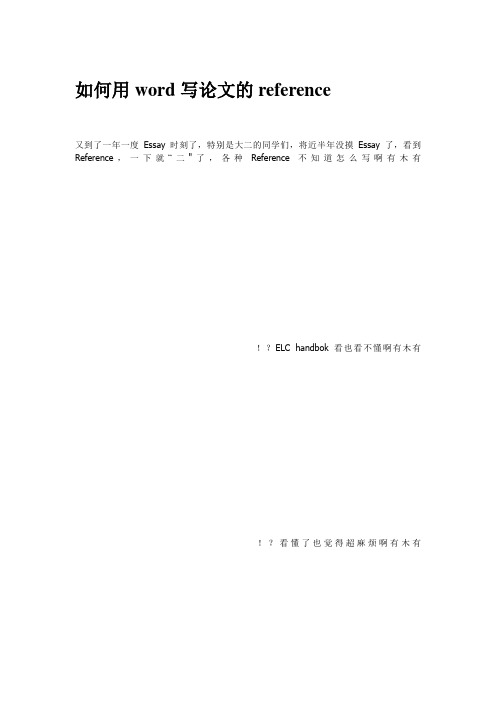
如何用word写论文的reference又到了一年一度Essay时刻了,特别是大二的同学们,将近半年没摸Essay了,看到Reference,一下就“二"了,各种Reference不知道怎么写啊有木有!?ELC handbok看也看不懂啊有木有!?看懂了也觉得超麻烦啊有木有!?斜体加粗咋用都不知道啊有木有?!如果你还在为Reference发愁,那么这篇日志将会帮助你~LZ是本着造福不会用的同学们的想法来的,肯定有许多大神已经对怎么用Word Reference 了然于胸,希望看后不要嗤之以鼻就可以了~3Q思密达(以下图片均来自舍友的坑爹Office2010,不知道为啥学校MIT办公室给装的Office里面没有学校要求的Harvard Style,但是没关系,学校机房里的Word是有的,至少大电气的EE机房里是有的!LZ亲测~哎呀我去一不小心暴露了专业。
)Step1. 打开Office,打开你的EssayStep2. 找到Reference标签Step3. 点击,找到Citation and Bibliography那一栏Step4. 点击Inert Citation,选择Add New SourceStep5. 在弹出的对话框里选择你的Reference种类,并填写相关的信息,打钩下面的Show All Fields可以填写更多信息,但是前面有红色标记的是比较重要的信息,推荐填写。
填写完成后点击OK。
Step6. 如果你有不止一个Source可以选择继续添加。
Step7. 点击Reference Style选择需要的格式,大家应该都是需要Harvard Style的吧~舍友的渣Word(在学校MIT办公室装的)没有Harvard Style,但是学校机房是有的~LZ亲测~Step8. 一切弄好之后回到你的Essay,把文字输入光标移动到你需要插入Reference的地方,点击Bibliography,选择Bibliography那一坨。
Reference 引用格式方法
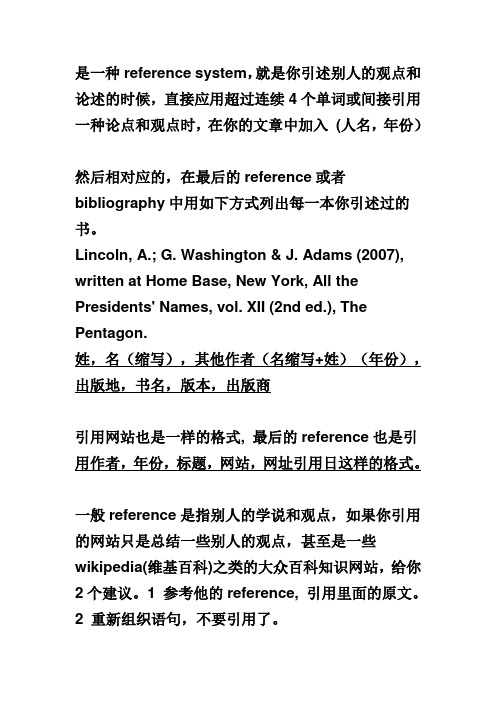
是一种reference system,就是你引述别人的观点和论述的时候,直接应用超过连续4个单词或间接引用一种论点和观点时,在你的文章中加入(人名,年份)
然后相对应的,在最后的reference或者bibliography中用如下方式列出每一本你引述过的书。
Lincoln, A.; G. Washington & J. Adams (2007), written at Home Base, New York, All the Presidents' Names, vol. XII (2nd ed.), The Pentagon.
姓,名(缩写),其他作者(名缩写+姓)(年份),出版地,书名,版本,出版商
引用网站也是一样的格式, 最后的reference也是引用作者,年份,标题,网站,网址引用日这样的格式。
一般reference是指别人的学说和观点,如果你引用的网站只是总结一些别人的观点,甚至是一些wikipedia(维基百科)之类的大众百科知识网站,给你2个建议。
1 参考他的reference, 引用里面的原文。
2 重新组织语句,不要引用了。
APA格式reference_写法【范本模板】
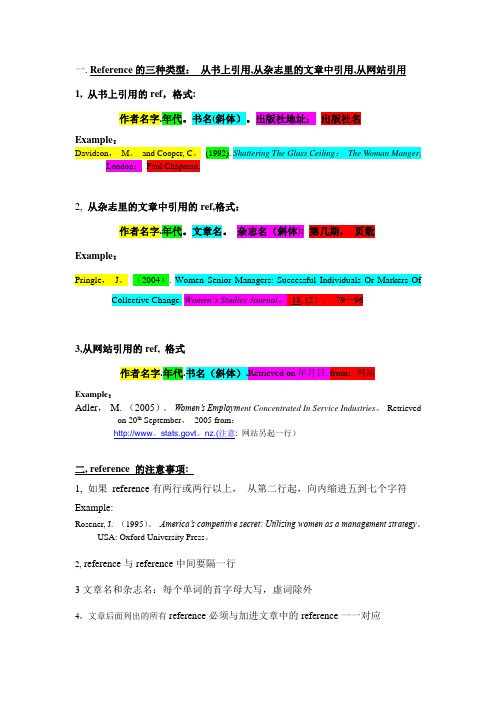
一.Reference的三种类型:从书上引用,从杂志里的文章中引用,从网站引用1, 从书上引用的ref,格式:作者名字.年代。
书名(斜体)。
出版社地址:出版社名Example:Davidson,M。
and Cooper, C。
(1992). Shattering The Glass Ceiling:The Woman Manger.London:Paul Chapman.2, 从杂志里的文章中引用的ref,格式:作者名字.年代。
文章名。
杂志名(斜体): 第几期,页数Example:Pringle,J。
(2004). Women Senior Managers: Successful Individuals Or Markers Of Collective Change. Women’s Studies Journal,18, (2),79—963,从网站引用的ref, 格式作者名字.年代.书名(斜体).Retrieved on年月日. from:网站Example:Adler,M. (2005)。
Women’s Employm ent Concentrated In Service Industries。
Retrieved on 20th September,2005 from:http://www。
t。
nz.(注意: 网站另起一行)二, reference 的注意事项:1, 如果reference有两行或两行以上,从第二行起,向内缩进五到七个字符Example:Rosener, J. (1995)。
America’s competitive secret: Utilizing women as a management strategy。
USA: Oxford University Press。
2, reference与reference中间要隔一行3文章名和杂志名:每个单词的首字母大写,虚词除外4,文章后面列出的所有reference必须与加进文章中的reference一一对应5, reference做完以后,以作者的首字为准,按字母顺序进行排列6,一般情况下,1000字,四个reference。
Reference书写格式和要求
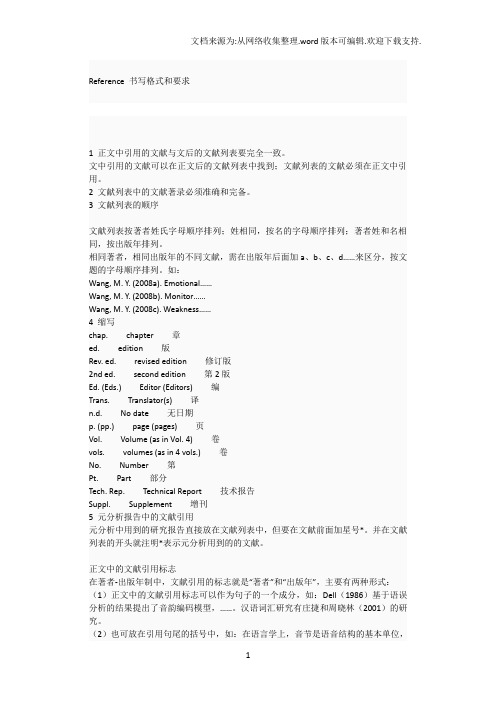
Reference 书写格式和要求1 正文中引用的文献与文后的文献列表要完全一致。
文中引用的文献可以在正文后的文献列表中找到;文献列表的文献必须在正文中引用。
2 文献列表中的文献著录必须准确和完备。
3 文献列表的顺序文献列表按著者姓氏字母顺序排列;姓相同,按名的字母顺序排列;著者姓和名相同,按出版年排列。
相同著者,相同出版年的不同文献,需在出版年后面加a、b、c、d……来区分,按文题的字母顺序排列。
如:Wang, M. Y. (2008a). Emotional……Wang, M. Y. (2008b). Monitor……Wang, M. Y. (2008c). Weakness……4 缩写chap. chapter 章ed. edition 版Rev. ed. revised edition 修订版2nd ed. second edition 第2版Ed. (Eds.) Editor (Editors) 编Trans. Translator(s) 译n.d. No date 无日期p. (pp.) page (pages) 页Vol. Volume (as in Vol. 4) 卷vols. volumes (as in 4 vols.) 卷No. Number 第Pt. Part 部分Tech. Rep. Technical Report 技术报告Suppl. Supplement 增刊5 元分析报告中的文献引用元分析中用到的研究报告直接放在文献列表中,但要在文献前面加星号*。
并在文献列表的开头就注明*表示元分析用到的的文献。
正文中的文献引用标志在著者-出版年制中,文献引用的标志就是“著者”和“出版年”,主要有两种形式:(1)正文中的文献引用标志可以作为句子的一个成分,如:Dell(1986)基于语误分析的结果提出了音韵编码模型,……。
汉语词汇研究有庄捷和周晓林(2001)的研究。
(2)也可放在引用句尾的括号中,如:在语言学上,音节是语音结构的基本单位,也是人们自然感到的最小语音片段。
Reference 标准格式
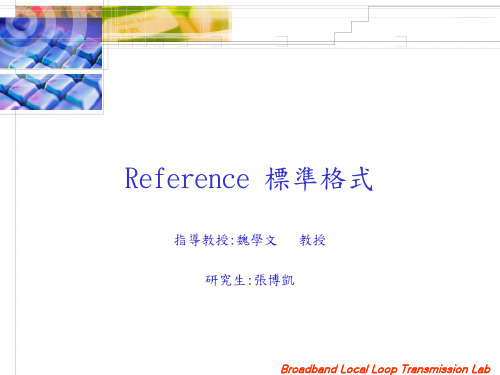
• 文獻之格式通常均有其慣例,雖然各種期刊所規定者可能略有出 入,但差異不大。但無論來源如何,最後必須修正為一致的格式。
General style
• Author names 不可省略作者姓名。假如作者超過三個人,則在第一位作者之後加 上〝ed al.〞例如:T.G. Lewis et al. • Dates Spell out May, June, and July; abbreviate the other months: Jan., Feb., Mar., Apr., Aug., Sept., Oct., Nov., and Dec. • Titles 需保留完整的標題,不可以增加或減少任何字元。如果是非中英文 的reference,如果可以的話,在原本的標題之後打上英文的標題。 除第一個字母與專有名詞大寫外,均以小寫為之。
• Book: Book: 可依下列次序書寫:作者姓名、書名、出版社、出版年、頁數。 例如: W.M. Newman and R.F. Sproull, Principles of Interactive Computer Graphics, McGraw-Hill, 1979, p. 402. • CD-ROM: CD-ROM: W.M. Newman and R.F. Sproull, Principles of Interactive Computer Graphics, CD-ROM , McGraw-Hill, 1979, p. 402. • 電子刊物: 電子刊物: Web site
R. Bartle, "Early MUD History," Nov. 1990; www.ludd.luth.se/mud/aber/mud-histo: http:// /mall/pacific/start.html http://www.web-pac. com/mall/pacific/start.html /mall/ pacific/start.html
apa格式reference模版
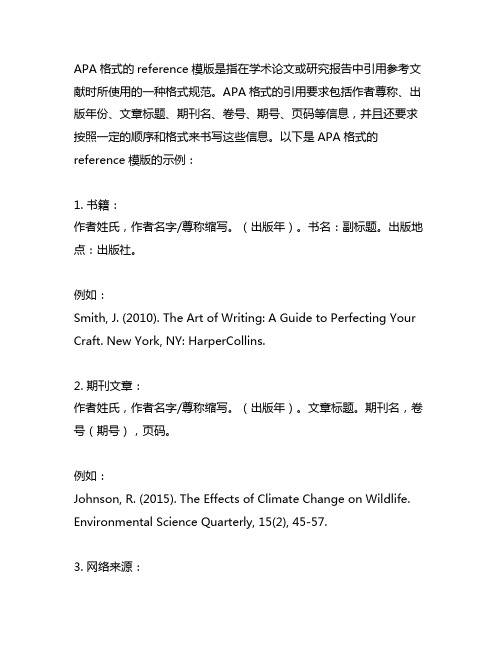
APA格式的reference模版是指在学术论文或研究报告中引用参考文献时所使用的一种格式规范。
APA格式的引用要求包括作者尊称、出版年份、文章标题、期刊名、卷号、期号、页码等信息,并且还要求按照一定的顺序和格式来书写这些信息。
以下是APA格式的reference模版的示例:1. 书籍:作者姓氏,作者名字/尊称缩写。
(出版年)。
书名:副标题。
出版地点:出版社。
例如:Smith, J. (2010). The Art of Writing: A Guide to Perfecting Your Craft. New York, NY: HarperCollins.2. 期刊文章:作者姓氏,作者名字/尊称缩写。
(出版年)。
文章标题。
期刊名,卷号(期号),页码。
例如:Johnson, R. (2015). The Effects of Climate Change on Wildlife. Environmental Science Quarterly, 15(2), 45-57.3. 网络来源:作者姓氏,作者名字/尊称缩写。
(出版年)。
文章标题。
全球信息站名。
获取日期,全球信息站。
例如:Brown, M. (2018). The Impact of Social Media on Mental Health. Psychology Today. Retrieved September 25, 2018, from xxx4. 研究报告:机构名。
出版年。
报告标题。
出版地点:出版社。
例如:National Institute of Mental Health. (2016). Mental Health in America: Prevalence and Treatment of Mental Illness. Washington, DC: Government Printing Office.5. 会议论文:作者姓氏,作者名字/尊称缩写。
论文reference格式写作规范

英文assignment的写作细节(请各位愿意长期合作的朋友,尽量仔细阅读,在行文中注意这些要求)我们的assignment通常分为两种形式,一是essay, 一是report.二者在形式上有所差别,essay 偏向于理论论述,report则大都结合case进行理论应用。
一篇assignment上面会对写成essay 还是report格式作出明确要求。
在阅读题目时,请尽量仔细。
相同点:1、字体:Times New Roman或者Arial, 字号:小四,行距:1.5倍。
请在写作之前就把这些格式调好,以避免写好后再调会出现一些意相不到的情况。
2、段与段之间隔行。
每段不要求像中文写作那样空两格,而是直接顶格写。
区别:Essay:Essay的写作相对report要简单一些。
通常只包括三个部分,Introduction, Main Body, Conclusion. Introduction 包括topic的背景介绍和论文的结构。
一般占总字数的10%左右。
Main Body是主体部分,占总字数80%左右。
如果题目中作了具体要求,就根据题目提到的几个方面来逐一讨论就可以了。
有的题目没有作具体要求,就根据自己的构思来写。
但要求有逻辑性。
Conclusion也是占10%,在这一段里把文章中的主要观点用一到两句话概括出来。
Essay的body部分不提倡用太多的标题,有的作业要求甚至会直接写明不能用任何的标题,所以为了保证文章结构的清晰性,段落间要有承上启下的句子,使结构清晰明了,文章结构很重要,老师非常重视,直接影响分数的好坏。
Reference的写作是essay和report都要涉及的,我放在最后来详细说。
Report:它的写法大体上和essay差不多,但要求要严格一些。
第一:标题页:顾名思义,将report的题目写在此页第二:Executive summary,是对文章的摘要,要把写这篇报告的目的(也就是为什么要写这篇报告),报告得出的结果,最后的结论,以及报告给出的建议一一交代清楚,但不需要交代题目背景,摘要的目的是让busy reader能快速掌握报告的全部内容。
APA格式reference_写法
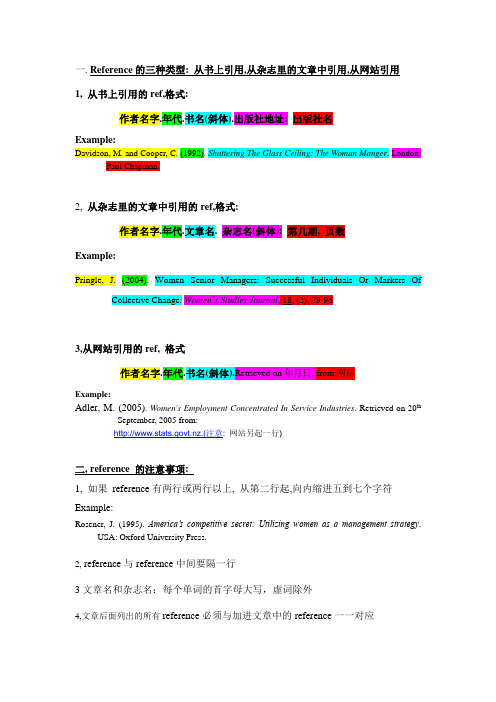
一.Reference的三种类型: 从书上引用,从杂志里的文章中引用,从网站引用1, 从书上引用的ref,格式:作者名字.年代.书名(斜体).出版社地址: 出版社名Example:Davidson, M. and Cooper, C. (1992). Shattering The Glass Ceiling: The Woman Manger. London: Paul Chapman.2, 从杂志里的文章中引用的ref,格式:作者名字.年代.文章名. 杂志名(斜体): 第几期, 页数Example:Pringle, J. (2004). Women Senior Managers: Successful Individuals Or Markers Of Collective Change. Women’s Studies Journal, 18, (2), 79-963,从网站引用的ref, 格式作者名字.年代.书名(斜体).Retrieved on年月日. from:网站Example:Adler, M. (2005). Women's Employment Concentrated In Service Industries. Retrieved on 20th September, 2005 from:.(注意: 网站另起一行)二, reference 的注意事项:1, 如果reference有两行或两行以上, 从第二行起,向内缩进五到七个字符Example:Rosener, J. (1995). America’s competitive secret: Utilizing women as a management strategy.USA: Oxford University Press.2, reference与reference中间要隔一行3文章名和杂志名:每个单词的首字母大写,虚词除外4,文章后面列出的所有reference必须与加进文章中的reference一一对应5, reference做完以后,以作者的首字为准,按字母顺序进行排列6,一般情况下,1000字,四个reference.这里需要强调一点:国外治学严谨,reference一定要做好!!我们的作业严禁直接抄书或从网上直接复制粘贴(这在国外被界定为抄袭)国外的学校有强大的数据库,抄袭的地方,数据库一搜就发现了一旦发现抄袭,客户轻则挂科,重则拿不到学位,诚信记录还要被写上一笔同时写手不但拿不到稿费,而且还要双倍赔款,终止合作所以在成为我们的写手之前我要把抄袭的问题先说清楚这也是我们这一行的行规你可以翻译中文也可以用自己的话把句子转述一遍但是直接引用和一个句子只改2、3个单词是一样会被判抄袭的!To develop a community profile (社区分布)for one Australian Local Government Area (LGA) of your choice, (excluding the City of Boroondara) using data from the 2001 and 2006 Census available from the ABS website. The focus of the demographic profile will be to describe up to three cultural characteristics of the population within your chosen LGA, and look at changes that have occurred from 2001 to 2006.Examples of cultural characteristics are ancestry, birthplace, language spoken, year of arrival in Australia, religious affiliation, English proficiency, and indigenous status. You are expected to synthesise (综合)the information available, not just replicate (折叠,复制)the tables that you can download. For example, you may choose to group a Census table detailing individual birthplaces into categories, and then show the proportional distribution - not just the number by birthplace; or from Year of Arrival in Australia you may derive the number of years living in Australia. In other words, you are required to analyse and summarise the information you find into your own summary tables and charts. In your demographic profile you should include summary tables, charts and commentary to support the graphs and tables. You should make use of data from both the 2001 Census and the 2006 Census (e.g. using a combination QuickStats, MapStats and Census Tables.制定一个社会形象之一澳大利亚地方政府区(儿)您的选择,(不包括城市Boroondara )使用数据从2001年和2006年人口普查可从澳大利亚统计局的网站上。
Essay写作中的Reference标注方式
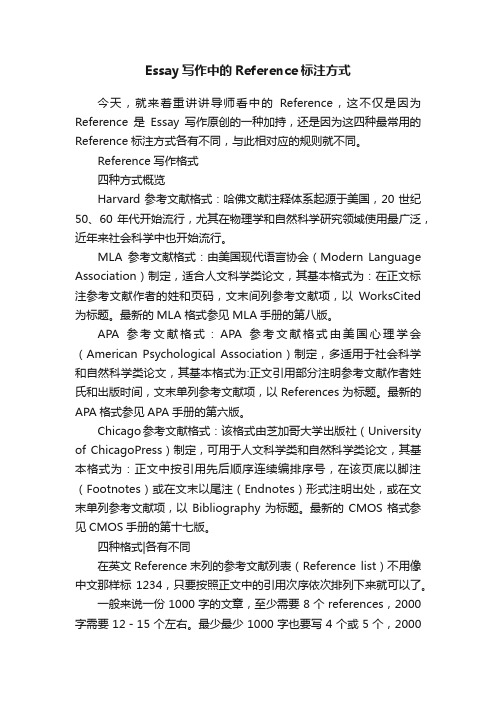
Essay写作中的Reference标注方式今天,就来着重讲讲导师看中的Reference,这不仅是因为Reference是Essay写作原创的一种加持,还是因为这四种最常用的Reference标注方式各有不同,与此相对应的规则就不同。
Reference写作格式四种方式概览Harvard参考文献格式:哈佛文献注释体系起源于美国,20世纪50、60年代开始流行,尤其在物理学和自然科学研究领域使用最广泛,近年来社会科学中也开始流行。
MLA参考文献格式:由美国现代语言协会(Modern Language Association)制定,适合人文科学类论文,其基本格式为:在正文标注参考文献作者的姓和页码,文末间列参考文献项,以WorksCited 为标题。
最新的MLA格式参见MLA手册的第八版。
APA参考文献格式:APA参考文献格式由美国心理学会(American Psychological Association)制定,多适用于社会科学和自然科学类论文,其基本格式为:正文引用部分注明参考文献作者姓氏和出版时间,文末单列参考文献项,以References为标题。
最新的APA格式参见APA手册的第六版。
Chicago参考文献格式:该格式由芝加哥大学出版社(University of ChicagoPress)制定,可用于人文科学类和自然科学类论文,其基本格式为:正文中按引用先后顺序连续编排序号,在该页底以脚注(Footnotes)或在文末以尾注(Endnotes)形式注明出处,或在文末单列参考文献项,以Bibliography为标题。
最新的CMOS格式参见CMOS手册的第十七版。
四种格式|各有不同在英文Reference末列的参考文献列表(Reference list)不用像中文那样标1234,只要按照正文中的引用次序依次排列下来就可以了。
一般来说一份1000字的文章,至少需要8个references,2000字需要12-15个左右。
留学生论文Reference怎么写--英语论文re.doc

留学生论文Reference怎么写----英语论文reference格式----参考文献论文-->留学生论文Reference怎么写,英语论文reference格式各位在国外留学的小伙伴们,是否经常因为Reference而感到头痛烦恼呢?确实,我们在写作留学生论文时既需要考虑Reference的格式,也需要考虑Reference要怎么写,那么这令人烦恼的reference 是什么意思呢?英语论文中的reference要怎么写?为了帮助各位留学生们解决论文写作带来的压力,下面这篇文章将为各位全面的解读英语论文reference该如何去写和运用。
essay referencing can be a headache at university. Hoany references do you need? any。
By knoake essay referencing easier, ake the process a little smoother.atterIncluding references in your essay is your arkers that you’ve truly engaged atter. It is also important as it proves that you’ve read the key sources ore helpful references you include, the more ed you appear to be about your topic. It’s not al your essay are really ic practice. If you go on to study further, ore about your subject or publish your ation and inspiration from is essential. A bibliography also provides a helpful resource you can go back to and use for future any references is too many referencesOf course, it is possible to use too many references. If you are using references just to shopress your markers. Y ou need to choose the sources ent, contesting it or prompting interesting, relevant questions.Remember, markers also any references does not leave much room for your personal standpoint to shine through. As a general rule, you should aim to use one to three, to support each key point you make. This of course depends on subject matter and the point you are discussing, but acts as a good general guide.It can be useful to have a best practice breakdoany references to use. Here’s a rough guide to help you get the balance right for any piece of academic ake up approximately 10% of your essay. Y ou may want to use one or two references to define your topic in this section, depending onyour word count.●Body.--> />The main body of your essay (ent) should make up approximately 75% of your essay.For example: In a 2000 ain point you make should typically use 1-3 paragraphs, for around 5 key points, each supported by 2 or 3 references. Try and use direct or primary references etimes you’ll need to use in-text references, too.●Conclusion.Y our conclusion should account for around 15% of your essay. Y ou may ents.Of course, it is really hard to suggest exactly hoany references your essay should include. This depends totally on the subject matter and ple, may have a lot of critical thinking and be quite theory-heavy, and for this reason you may need more references than a typical English Literature Essay. This is just an example –you’ll need to consider your oatter and topic.agazinesEssaysNemesAny external source以上就是关于留学生论文reference是什么以及怎么写的指导,希望能够帮助到各位留学生们提升自己的论文写作能力和对于reference 使用的理解。
reference哈佛格式

reference哈佛格式
哈佛格式是一种常用的学术引用格式,它要求在论文中对引用
的来源进行详细的标注,以便读者可以查证。
在哈佛格式中,引用
的来源包括作者的姓名、出版年份、文章标题、期刊名称、卷号、
页码等信息,具体格式如下:
书籍引用格式:
作者姓氏,作者名字年份,书名,出版地点,出版社。
期刊文章引用格式:
作者姓氏,作者名字年份,文章标题,期刊名,卷号(期号),页码。
网页引用格式:
作者姓氏,作者名字年份,文章标题,网页名称,网页地址,(访问日期)。
在哈佛格式中,每个引用都需要在论文的引用部分列出,并按照字母顺序排列。
此外,引文中的作者姓名和出版年份需要在引用部分的列表中以及正文中进行标注。
总体来说,哈佛格式要求对引用的来源进行详细的标注,并且要求标注的信息能够帮助读者准确地找到引用的原始来源。
这种格式的引用方法可以帮助提高论文的学术可信度,同时也是学术界广泛接受的引用格式之一。
如何用word写论文的reference

如何用word写论文的reference又到了一年一度Essay时刻了,特别是大二的同学们,将近半年没摸Essay了,看到Reference,一下就“二"了,各种Reference不知道怎么写啊有木有!?ELC handbok 看也看不懂啊有木有!?看懂了也觉得超麻烦啊有木有!?斜体加粗咋用都不知道啊有木有?!如果你还在为Reference发愁,那么这篇日志将会帮助你~LZ是本着造福不会用的同学们的想法来的,肯定有许多大神已经对怎么用Word Reference了然于胸,希望看后不要嗤之以鼻就可以了~3Q思密达(以下图片均来自舍友的坑爹Office2010,不知道为啥学校MIT办公室给装的Office里面没有学校要求的Harvard Style,但是没关系,学校机房里的Word是有的,至少大电气的EE机房里是有的!LZ亲测~哎呀我去一不小心暴露了专业。
)Step1. 打开Office,打开你的EssayStep2. 找到Reference标签Step3. 点击,找到Citation and Bibliography那一栏Step4. 点击Inert Citation,选择Add New SourceStep5. 在弹出的对话框里选择你的Reference种类,并填写相关的信息,打钩下面的Show All Fields可以填写更多信息,但是前面有红色标记的是比较重要的信息,推荐填写。
填写完成后点击OK。
Step6. 如果你有不止一个Source可以选择继续添加。
Step7. 点击Reference Style选择需要的格式,大家应该都是需要Harvard Style的吧~舍友的渣Word(在学校MIT办公室装的)没有Harvard Style,但是学校机房是有的~LZ亲测~Step8. 一切弄好之后回到你的Essay,把文字输入光标移动到你需要插入Reference的地方,点击Bibliography,选择Bibliography那一坨。
学术论文reference格式总体要求
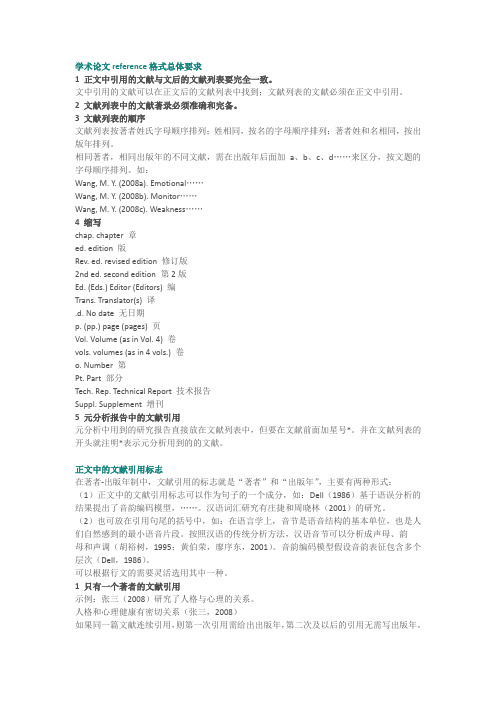
母和声调(胡裕树,1995;黄伯荣,廖序东,2001)。音韵编码模型假设音韵表征包含多个层次(Dell,1986)。
可以根据行文的需要灵活选用其中一种。
3两篇文献的著者的姓氏相同
则需给出名的缩写,以免混淆。如:K. D. Wang (2007)和P. G. Wang (2008)研究了……
4同时引用多篇文献
著者相同,出版年不同,按出版年排序。如:过去的研究(Edeline & Weinberger, 2002a, 2002b, 2005, in press)表明……。
文献列表中文献各成分的要求
1文献各组成部分
·文献的组成部分有:著者,出版日期,文题或章节的题目,出版信息(刊名、卷号和页码,章节的页码范围和出版地),获取信息的日期和来源等。不同类型的文献有不同的要求。
·每个部分用点号结束。
2著者
文献著录的第一部分是著者姓名。
·姓需全拼,名只写首字母;姓氏后面有逗号,名的缩写现方式做保护处理对用户上传分享的文档内容本身不做任何修改或编辑并不能对任何下载内容负责
学术论文reference格式总体要求
1正文中引用的文献与文后的文献列表要完全一致。
文中引用的文献可以在正文后的文献列表中找到;文献列表的文献必须在正文中引用。
2文献列表中的文献著录必须准确和完备。
示例:张三、李四和王五(2008)发现了……,这个结果在Wang, Zhao和Sun(2009)的研究中得到重复。未来的研究还需关注环境的影响(赵一,周二,陈三,2008;Wolchik, Sandler, & West, 2007)。
如何写reference宝典
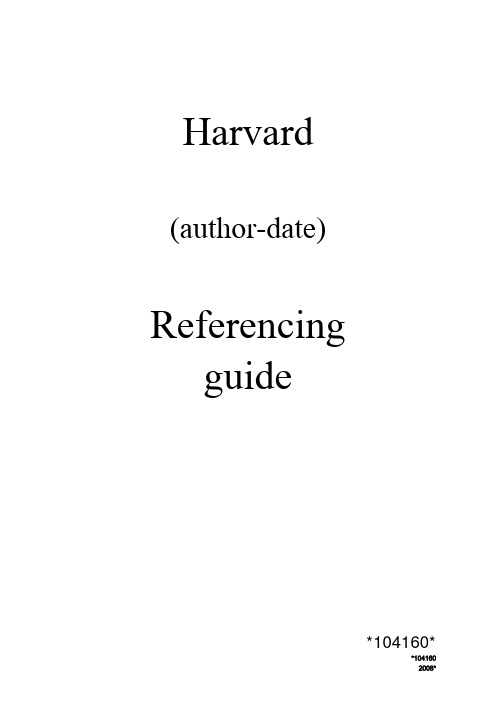
Harvard (author-date) Referencingguide*104160**1041602008*Harvard (author-date) referencing guideEdition 2009Produced and printed by theDivision of Teaching & Learning ServicesCQUniversity AustraliaRockhampton, Queensland.COMMONWEALTH OF AUSTRALIACopyright Regulations 1969WARNINGThis material has been reproduced and communicated to you by or on behalf of Central Queensland University pursuant to Part VB of the Copyright Act 1968 (the Act).The material in this communication may be subject to copyright under the Act. Any further reproduction or communication of this material by you may be the subject of copyright protection under the Act.Do not remove this notice.CQU CRICOS Codes: 00219C - Qld; 01315F - NSW; 01624D - VicD E V E L O P E D B YAcademic Learning SupportDivision of Teaching and Learning ServicesDivision of Teaching & Learning ServicesRockhampton, Queensland Australia2This is a guide to the Harvard author-date referencing system. It is based on the following manual:Commonwealth of Australia 2002, Style manual for authors, editors and printers, 6th edn, rev. by Snooks & Co., John Wiley & Sons Australia, Brisbane. Copyright: Commonwealth of Australia, reproduced by permission.This guide has been written primarily for the use of students undertaking the preparatory program, STEPS, at CQUniversity. At an undergraduate level, this document should be used for guidance only. Undergraduates should also consult their Study Guides and lecturers to find out which referencing conventions are preferred for their courses.Documents from the University of South Australia and the University of Adelaide provided the inspiration for the format of this referencing guide.This document can be found on CQUniversity’s website. Go to<.au/referencing> and click on Harvard (author-date).3Harvard (author-date) referencing guideContentsWhat is referencing? (5)Why should you reference? (5)Should you reference public domain information? (5)What is plagiarism and how can you avoid it? (7)Which referencing system should you use? (8)Principles of author-date referencing (8)Ways of citing (9)Paraphrasing (10)Paraphrase or use quotations? (10)Using direct quotations (12)Page numbers (14)Acronyms and initialisms (14)Difference between a reference list and a bibliography (15)Features of the reference list (16)Frequently asked questions (FAQs) (19)Harvard in-text and reference list models (21)Quick guide to referencing models (22)Hard copy books (24)Electronic books (29)Hard copy journal articles (30)Online or electronic journals (31)Hardcopy—newspaper articles (32)Electronic copy—newspaper articles (33)Other documents on the World Wide Web (WWW) (34)Government sponsored websites (35)Hard copy government or legal documents (37)Hard copy university provided study materials (39)Electronic copy university provided study materials (41)Specialised sources (42)Evaluating websites for educational use (48)Sample reference list (49)Bibliography (50)Index (51)4What is referencing?When you write an assignment at university, you are required to refer to the work of other authors. Each time you do so, it is necessary to identify their work by making reference to it—both in the text of your assignment and in a list at the end of your assignment. This practice of acknowledging authors is known as referencing.References must be provided whenever you use someone else’s opinions, theories, data or organisation of material. You need to reference information from books, articles, videos, computers, other print or electronic sources, and personal communications. A reference is required if you:•quote (use someone else’s exact words)•copy (use figures, tables or structure)•paraphrase (convert someone else’s ideas into your own words)•summarise (use a brief account of someone else’s ideas).Why should you reference?References enhance your writing and assist your reader by:•showing the breadth of your research•strengthening your academic argument•showing the reader the source of your information•allowing the reader to consult your sources independently•allowing the reader to verify your data.Should you reference public domain information?Public domain information is information that is so widely known that it is considered everybody would be aware of its source. The general public use public domain information freely. Where authors or sources are so widely known, specific citation may not be required. Check with your lecturer on this issue.For example:As Shakespeare observed, ‘All the world’s a stage …’.5Harvard (author-date) referencing guide6The quick guide to referencingRobert Harris designed this simple flowchart to assist students to cite their research properly.Source: Harris (2001, p. 155)Source: Harris (2001, p. 158)These flowcharts can be found in Harris, R2001, The plagiarism handbook: strategies for preventing, detecting and dealing with plagiarism, Pyrczak, Los Angeles.What is plagiarism and how can you avoid it? Plagiarism is the intentional use of someone else’s ideas, words or concepts in your assignment work. It is considered serious misconduct at university and should be avoided at all times. CQUniversity has a policy on plagiarism and you are strongly encouraged to familiarise yourself with it. The following URL will lead you to the plagiarism policy:.au/Policy/policy_file.do?policyid=198Committing plagiarism can carry very serious penalties for students, including expulsion from a university. (Note:Expulsion for some international students may mean having to return to their own country because this forfeits their student visa.) Regrettably, students have been known to commit offences of plagiarism by not understanding what acceptable paraphrasing, summarising or quoting techniques are. This is discussed later in this guide.The best way to avoid being accused of plagiarism is to acknowledge the resources upon whichyou have based your ideas.7Harvard (author-date) referencing guideWhich referencing system should you use?There are a number of different referencing systems used in academic writing. CQUniversity acknowledges:•author-date systems commonly known as Harvard and APA (American Psychological Association)•footnoting or endnoting systems commonly used in History and Law.It is important that you use the referencing system required by your lecturer for an assignment and maintain consistency in using that system.This guide explains the Harvard system of author-date referencing. The information it contains is based on:Commonwealth of Australia 2002, Style manual for authors, editors and printers, 6th edn, rev. by Snooks & Co., John Wiley & Sons Australia, Brisbane. Copyright: Commonwealth of Australia, reproduced with permission.Principles of author-date referencingThere are two parts to the author-date system of referencing:1.the author and the date are referred to in the text or main body of your writing (calledembedded or in-text referencing)2.all of the resources referred to in the body of the writing are included in the reference list atthe end of the assignment. All information is included in this list: author, date, title ofpublication, publisher and where it was published.The other features of author-date referencing include:• a specific order in which this information should be structured•the in-text reference which should be placed (cited) in such a way that it causes minimal disruption to the flow of your writing—this usually means at the very end or the verybeginning of your sentences.When you cite sources of information in the text of your assignment—regardless of whether you quote, copy, paraphrase or summarise—you should include:•the author’s surname (family name)•the year of publication (latest edition)•page numbers when directly quoting or closely paraphrasing an author’s words/material •correct punctuation and spacing.8Ways of citingThere are two ways of citing: author prominent and information prominent.Author prominentThis way gives prominence to the author by using the author’s surname (family name) as part of your sentence with the date and the page number in parentheses (round brackets).Direct quote exampleUnterhalter (2007, p. 5) argues that ‘gender equality in schooling is an aspiration of global social justice’.Paraphrase exampleUnterhalter (2007, p. 5) suggests that equal treatment of the genders in education should be the goal of every just society.Information prominentThe other way of citing gives prominence to the information, with all the required referencing details in parentheses at the end of the citation.Direct quote exampleIt has been argued that ‘gender equality in schooling is an aspiration of global social justice’ (Unterhalter 2007, p. 5).Paraphrase exampleEqual treatment of the genders in education should be the goal of every just society (Unterhalter 2007, p. 5).Verbs that help with author-prominent referencing9Harvard (author-date) referencing guideParaphrasingParaphrasing means to restate accurately and succinctly in your own words something you have read. If your work does not refer to specific ideas on particular pages of a resource but to general themes mentioned throughout the resource, page numbers need not be shown.General themeTertiary study requires various literacy skills (Doyle 2006).Specific ideaAccording to Harper (1986, cited in Doyle 2006, p. 7), a sound level of maths is necessary to undertake university study.Paraphrase or use quotations?It is preferable that you paraphrase (put ideas in your own words) as too many quotations (using the exact words) can lead to a poorly written assignment. A general rule in academic circles is that no more than 10% of an assignment should be in the form of direct quotations. No matter whether you use quotations or paraphrase another’s words, you always need to give references—both in the text and in the reference list.We have used samples of text from CQUniversity’s (then Central Queensland University’s) plagiarism policy from 2002 to illustrate acceptable and unacceptable methods of using information in your assignments.Original text from plagiarism policy3. PlagiarismThe University views the process of circumventing or attempting to circumvent assessment requirements very seriously. Consequently conduct of that sort may result in the suspension or exclusion of the student. Plagiarism involves submitting or presenting work in a course as if it were the student’s own work done expressly for that particular course when, in fact, it is not. Most commonly, plagiarism exists when:3.1 the work submitted or presented was done, in whole or in part, by an individual other thanthe one submitting or presenting the work (this includes having another impersonate the student or otherwise substituting the work of another for one’s own in an examination or test);3.2 parts of the work are taken from another source without reference to the original author; 3.3 the whole work, such as an essay, is copied from another source; and3.4 a student submits or presents work in one course which has also been submitted in anothercourse (although it may be completely original with that student) without the knowledge, or prior agreement of the instructor involved.The above is taken from Central Queensland University (CQU) 2002, Undergraduate handbook, Central Queensland University, Rockhampton, p. 50.10Unacceptable: word-for-word copyingCentral Queensland University (CQU) views the process of attempting to circumvent assessment requirements very seriously. Indeed conduct of that sort may result in the suspension or exclusion of a student. Plagiarism is when a student submits or presents work in a course as if it were their own work, that they have done for that course when, in fact, it is not.Usually, plagiarism exists when: an individual other than the one undertaking the course, produces the work submitted or presented for that course; some parts of the work (assignment/s) submitted are taken from other sources but these sources are not referenced; the whole work, such as an essay or research report, is copied from another source; and a student submits or presents work in one course which was also submitted in another course without the prior agreement of the instructor involved. This can even be the case if the work was completely original with that student.Why is this an unacceptable use of the original text?The words in italics are taken directly from the original source. In addition, the structure of the discussion is a direct reflection of the original source. Even if this material had been referenced with a citation this is still unacceptable. This is because the content has been so closely presented as to not truly reflect original use of the material. That is, the wording is virtually exactly from the Undergraduate handbook and the flow of ideas is also from the Undergraduate handbook. Although this version could have used quotation marks and citation details to adequately reference the content, it would have been so cluttered that it would read as poor quality work. If the concept or wording is so important to retain, then a direct quote is a better way to present the work. However, keep in mind that direct quoting should be used conservatively in any piece of work that you present.The overuse of quoting can distract from the flow of your discussion and also fail to demonstrate your understanding of the original material.Unacceptable: poor cut-and-paste practicePlagiarism most commonly exists in four ways. The first is when the work submitted or presented was done by someone other than the one submitting the work. The second is when the whole work, such as an essay, is copied from some other source. The third is when parts of the work are taken from another source and no reference is made to the original author. The last is when a student submits or presents work in one course which has also been submitted in another course and has not sought approval from the course coordinator to do so; this is also plagiarism. It can be seen, therefore, that plagiarism involves submitting or presenting work in a course as if it were the student’s own work done expressly for that particular course when, in fact, it is not (Central Queensland University [CQU] 2002, p. 50).Why is this an unacceptable use of the original text?This is still an unacceptable paraphrasing of the original, even though a citation has been provided. This is because sections of the original source have simply been reordered and the original wording is still present (those words in italics). This version of the original is simply reflecting the student’s ability to cut-and-paste words from another source, and still does not demonstrate their own comprehension of the material.Although this version could have used quotation marks and a citation to reference the content adequately, it would have been so cluttered that meaning would have been lost.If it is important to retain the original wording, then use of a direct quote would be a better way to present the work. The use of the citation at the end of the paragraph is still inadequate for academic writing.Acceptable: paraphrasing and acknowledging sourceThe Central Queensland University (CQU) takes plagiarism ‘very seriously’ (CQU 2002, p. 50). Indeed, in the Undergraduate handbook (CQU 2002, p. 50), the issue of plagiarism is discussed and four examples of types of plagiarism are presented. These range from copying an entire piece of work without acknowledging that copying has occurred, through to having someone else do the work and then claim it as one’s own. Both of these are unacceptable. From the discussion in the Undergraduate handbook, it appears that it is also unacceptable if even only part of the work is copied and not acknowledged. The fourth example given in the Undergraduate handbook suggests that students can even ‘plagiarise’ their own work. This happens when a student has written an assignment for one course and then attempts to use the same assignment in another course (or courses). It is therefore important to acknowledge where information comes from and how it is being used in an assignment, or else the student may run the risk of committing plagiarism.Why is this acceptable use of the original text?The above example has made use of the ideas and concepts of the original text and demonstrated comprehension. Only a small amount of direct quoting was used and this was clearly indicated with the use of quotation marks and citation detail. In addition, the entire paragraph clearly establishes its relationship to the original text while not using the words or exact structure of the original. This type of paraphrasing demonstrates a student’s ability to analyse and apply information to their specific question.Using direct quotationsQuotations should be used sparingly, selected carefully, used in context, integrated into your text and reproduced exactly (including the words, spelling, punctuation, capitalisation and paragraphing of the original writer). The word [sic] (meaning so or thus) can be inserted in a quotation when the original text is incorrect with regard to grammar or spelling, or contains sexist or racist language. For example:•According to Bloggs (2006, p. 21), the alarming growth in obesity levels in Australia can be attributed to ‘cendentary [sic] lifestyles, time saving household devices and the rapid growth of the fast food industry’.•Smith (2006, p. 21) raises a contentious issue in the discipline debate with the belief that ‘when a child is at school, he [sic] must comply with the school rules unquestionably’. •According to Jones (2004, p. 6), the Australian Government has not done enough to eradicate the feral cat and he states that ‘mandatory desexing of household cats ten years ago would of [sic] reduced feral cat numbers by 70% in 2003’.A quotation is used if:•misinterpretation would result from a change to the words• a major argument needs to be recorded as evidence•it is important to comment on, refute, or analyse the ideas expressed•it is a particularly elegant or forceful phrase.Short quotationsShort quotations (fewer than 30 words) should:•be incorporated into your sentence without disrupting the flow of your paragraph•have single quotation marks•have the full stop after the citation if the quote is information prominent•keep the same font size.Incorporating a quote as part of your sentence—information prominentStudents are initially nervous; however, ‘When students conquer the challenging initial days of the program, they begin to settle into a routine’ (Doyle 2006, p. 86).Incorporating a quote as part of your sentence—author prominentStudents are initially nervous; however, as Doyle (2006, p. 86) suggests, ‘When students conquer the challenging initial days of the program, they begin to settle into a routine’.Long quotationsLong quotations (more than 30 words) should:•be introduced in your own words•begin on a new line•be fully indented by default (i.e. 1.27 cm) from the left margin•be in single line spacing•use a smaller font for the quotation, that is, change from size 12 to size 11•not be enclosed in quotation marks.Separate the quotation from the lead-in statement with one blank line. The lead-in statement ends with a colon (:). Separate the quotation from the text that follows it with one blank line. This is illustrated below.Introducing a long quote—information prominentThough many may recoil from making their private lives public in digital spaces, there are obvious benefits for young people:The public life is fun. It’s creative. It’s where their friends are. It’s theatre, but it’s also community: in this linked, logged world, you have a place to think out loud and be listened to, to meet strangers and godeeper with friends. (Nussbaum 2007, p. 27)Introducing a long quote—author prominentRowan (2001, p. 39) summarises the effects of a limited world view when she states that: This poses a real challenge for educators. In many cases, we are drawing on educational resources,or curriculum documents which are themselves fairly narrow in the view of the world theyrepresent. This helps to make this view seem natural and normal.If educators have a limited world view they will be unaware of the gaps in texts.Words omitted from quotationsTo omit words from quotations, use an ellipsis (…). The quotation must still keep the same sense.Biggs (2007, p. 44) argues that in ‘constructive alignment … objectives are defined not just in terms of content, but also in terms of the level of understanding applied to that content’. Double quotationsFor a double quotation—that is, a quotation within a quotation—use double quotation marks inside single quotation marks:‘The first words of Melville’s Moby Dick are “Call me Ishmael” and these words are full of significance’ was the first statement in Smith’s memorable speech (Johns 1995, p. 43). Square brackets in quotationsSometimes in quotations it is necessary to insert a word that explains the meaning of another word in that quotation. Place the explanation in square brackets.According to Cowie et al. (1996, p. 21), ‘The curriculum of the national schools in the 1870s included reading, writing, arithmetic, drill [physical exercises] and music’.Page numbersPage numbers should be used when you directly quote material (word-for-word) from the original publication. This includes tables or figures. Page numbers should also be used for indirect quotes and paraphrasing where the summarised material appears in specific pages, chapters or sections.The following examples illustrate the use of page numbers.Acronyms and initialismsAcronyms are words made up of the initial letters of a series of words. Examples are TAFE (from Technical and Further Education) and QANTAS (from Queensland And Northern Territory Aerial Services Ltd.)Initialisms are abbreviations made up of the initial letters of a series of words. Examples are NSW (for New South Wales) and NLA (for National Library of Australia).If you are referring numerous times to an organisation with a long title, you may use the relevant acronym or initialism. The first time you refer to the organisation, include both the full title and, in parentheses (round brackets), the acronym or initialism. Thereafter, the acronym or initialism will suffice. Both acronyms and initialisms are written without full stops.ExampleThe Royal Society for the Prevention of Cruelty to Animals (RSPCA) has a policy onremoving injured animals. The RSPCA is permitted to enter a property at any time followinga report of complaint (RSPCA 2006).In the reference list, both the long title and the acronym or initialism must be included. For example:Royal Society for the Prevention of Cruelty to Animals (RSPCA) 2006, Policy statement on removal of animals at risk, RSPCA, Brisbane.Use of Latin termsSome Latin terms are still used in referencing. They are so commonly used in English that they are not presented in italics.Difference between a reference list and a bibliographyThe reference list includes only sources referred to (cited) in the text of your assignment. You may also be required to provide a bibliography. A bibliography is presented in the same format as a reference list but it includes all material consulted in the preparation of your assignment. In other words, a bibliography presents the same items as a reference list but it also includes all other sources which you read or consulted but did not cite.Features of the reference listElements for referencing a bookFor a book, the following elements should be presented in this order:•surname and initials of author(s)•year of publication•title of book in italics and minimal capitalisation•the edition, if not the original publication, for example, 4th edn•publisher•place of publication.There should be commas between all elements except the initials of the author(s) and the date. BookElements for referencing a journal articleFor a journal article, the following elements should be presented in this order: •surname and initials of author(s)•year of publication•title of article in single quotation marks and minimal capitalisation•title of journal or periodical in italics and maximal capitalisation•volume number where applicable•issue number or other identifier where applicable, for example, Winter•page number(s).Authors’ surnamesand initials Title of book inminimalPublisherPlace (city) ofpublicationbook title except author(s) and date the endJournal articleStove, RJ 1999, ‘Xenophobia: the great local content myth’, Institute of Public Affairs Review ,Arranging the reference list1. The reference list is arranged in alphabetical order according to the author’s family name.(Do not use numbers, letters or bullet points to begin each entry.)2. Any reference that starts with a number (e.g. ‘1973 AD to 1981 AD’ n.d .) precedes thealphabetical listing and is listed numerically.3. Where there is more than one author of a publication, maintain the order of their names asthey appear on the title page of the publication, even if they are not in alphabetical order on the title page.4. If a reference has no author, list it alphabetically according to the sponsoring body, forexample, CSIRO or Education Queensland.5. If there is no author or sponsoring body, list alphabetically according to the title. The wholetitle of the resource must appear, but when listing alphabetically, ignore words such as ‘The’, ‘A’, ‘An’ at the beginning of the reference’s title. For example, ‘The Australian child’ should be alphabetised according to the ‘A’ in ‘Australian’.6. If there are two or more references by the same author, then list them in order of publicationdate with the oldest work first.7. If references by the same author have been published in the same year, then list themalphabetically according to the title and add the letter ‘a’ after the first date, and ‘b’ after the second date, and so on (e.g. 2007a, 2007b, 2007c).Formatting the reference listThe reference list should begin on a new page.The title should be References and it should be:• bold• left aligned• in the same font size as the document, 12 pt.Note: headings are neither underlined nor punctuated.Author’s surnameand initials Year of publication Title of article in minimal capitalisation and in single quotation Italics and maximal capitalisation for journal titleVolume and issuenumber in lowercase Page numbers Full stop at the endThe references contained in the list should:•be in single line spacing•have a blank single line space between each reference (Hint: use paragraph spacing of 12 pt) •be left aligned•be arranged alphabetically•be the final page of your assignment. (Any appendices are placed after the reference list.)A sample reference list illustrating this formatting has been provided at the end of this guide on page 49.CapitalisationSome lecturers/faculties require a specific form of capitalisation in the reference list. Check to see if there is a specific requirement and follow it. If there is no requirement, the Harvard author-date system endorses minimal capitalisation.The following examples highlight the differences between minimal and maximal capitalisation. Minimal capitalisation‘Green light for operation glass ceiling’ 1999, Queensland women, viewed 22 May 2000, .au/qwo/9712/ceiling.htmlKaye, M 1994, Communication management,Prentice-Hall, Sydney.Maximal capitalisationAnderson, A & Ellis, A 2001, ‘Using Desktop Video to Enhance Music Instruction’, Australian Journal of Educational Technology, vol. 17, no. 3, pp. 279–294.Crystal, D 1996, Discover Grammar, Pearson Education, Harlow.。
Reference格式问题一定要注意
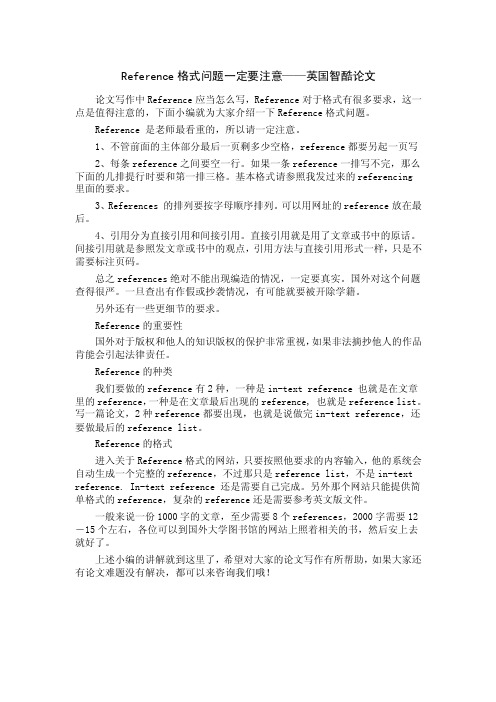
Reference格式问题一定要注意——英国智酷论文论文写作中Reference应当怎么写,Reference对于格式有很多要求,这一点是值得注意的,下面小编就为大家介绍一下Reference格式问题。
Reference 是老师最看重的,所以请一定注意。
1、不管前面的主体部分最后一页剩多少空格,reference都要另起一页写2、每条reference之间要空一行。
如果一条reference一排写不完,那么下面的几排提行时要和第一排三格。
基本格式请参照我发过来的referencing 里面的要求。
3、References 的排列要按字母顺序排列。
可以用网址的reference放在最后。
4、引用分为直接引用和间接引用。
直接引用就是用了文章或书中的原话。
间接引用就是参照发文章或书中的观点,引用方法与直接引用形式一样,只是不需要标注页码。
总之references绝对不能出现编造的情况,一定要真实。
国外对这个问题查得很严。
一旦查出有作假或抄袭情况,有可能就要被开除学籍。
另外还有一些更细节的要求。
Reference的重要性国外对于版权和他人的知识版权的保护非常重视,如果非法摘抄他人的作品肯能会引起法律责任。
Reference的种类我们要做的reference有2种,一种是in-text reference 也就是在文章里的reference,一种是在文章最后出现的reference, 也就是reference list。
写一篇论文,2种reference都要出现,也就是说做完in-text reference,还要做最后的reference list。
Reference的格式进入关于Reference格式的网站,只要按照他要求的内容输入,他的系统会自动生成一个完整的reference,不过那只是reference list,不是in-text reference. In-text reference 还是需要自己完成。
如何写reference

Citing References – this is a quick guide for students with examples of:1.How to cite sources in the body of theessay/paper.2.How to compile a references section atthe end of the essay/paperWhen writing in academic style, you will need to refer in your text to all material written or produced by others. This procedure is called citing or quoting references.Consistency and accuracy in citing sources are important to enable readers to identify and locate the material to which you have referred.Note: There are a number of other systems used for referencing (in addition to several different interpretations of the Harvard System.) If an alternate method is chosen (or required) the same set of rules should be followed every time you cite a source***The Harvard System (Author Date Method) All statements, opinions, conclusions etc. taken from another writer’s work should be cited, whether the work is directly quoted, paraphrased or summarised. In the Harvard System cited publications are referred to in the text by giving the author’s surname and the year of publication. These publications are also listed in the references at the end of the text.Originators/authorsThe person or organisation shown most prominently in the source as responsible for the content in its published form should be given. For anonymous works use ‘Anon’ instead of a name. For certain kinds of work, e.g. dictionaries or encyclopaedias, or if an item is the co-operative work of many individuals, none of whom have a dominant role, e.g. videos or films, the title may be used instead of an originator or author.DatesIf an exact year or date is not known, an approximate date preceded by ‘ca.’ may be supplied and given in square brackets. If no such approximation is possible, that should be stated, e.g. [ca.1750] or [no date].Citation in the textQuotations – As a general rule, if the quote is less than 4 lines, it may be included in the body of the text in quotation marks. Longer quotations are indented and single-spaced, and quotation marks are not required. For citations from particular parts of the document, the page numbers should be given in parentheses after the year.Summaries or paraphrases – Give the citation where it occurs naturally or at the end of the relevant piece of writing. Diagrams, illustrations should be referenced as though they were quotations if they have been taken from a published work. If details of particular parts of a document are required, e.g. page numbers, they should be given after the year within the brackets.Rules for citation in text for printed documents also apply to electronic documents except where pagination is absent. If an electronic document does not include pagination or an equivalent internal referencing system, the extent of the item may be indicated in terms such as the total number of lines, screens, etc., e.g. "[35 lines]" or "[approx. 12 screens]".Examples of citation in the text1. If the author’s name occurs naturally in the sentence the year is given in parentheses:e.g. In a popular study Harvey (1992) argued that we have to teach good practices…e.g. As Harvey (1992, 21) said, “good practices must be taught” and so we…2. If the name does not occur naturally in the sentence, both name and year are given in parentheses:e.g. A more recent study (Stevens 1998) has shown the way theory and practical work interact.e.g. Theory rises out of practice, and once validated, returns to direct or explain the practice (Stevens 1998).3. When an author has published more than one cited document in the same year, these are distinguished by adding lower case letters (a,b,c, etc.) after the year and within the parentheses:e.g. Johnson (1994a) discussed the subject…4. If there are two authors the surnames of both should be given:e.g. Matthews and Jones (1997) have proposed that…5. If there are more than two authors the surname of the first author only should be given, followed by et al.:e.g. Office costs amount to 20% of total costs in most businesses (Wilson et al. 1997).(A full listing of names should appear in the end references.)6. If the work is anonymous then “Anon.” should be used:e.g. In a recent article (Anon. 1998) it was stated that…7. If it is a reference to a newspaper article with no author, the name of the paper can be used in place of “Anon.”:e.g. More people than ever seem to be using retail home delivery (The Times 1996).(You should use the same style in the end references.)8. If you refer to a source directly quoted in another source you cite both in the text:e.g. A study by Smith (1960 cited in Jones 1994, 63) showed that…You should list only the work you have read (i.e. Jones) in the list of references.9. If you refer to a contributor in a source (chapters in books, articles in journals, papers in conference proceedings), you cite just the contributor in the in-text references:e.g. Software development has been given as the cornerstone in this industry (Bantz 1995).10. If you refer to a person who has not produced a work, or contributed to one, but who is quoted in someone else’s work, it is suggested that you should mention the person’s name and you must cite the source author:e.g. Richard Hammond stressed the part psychology plays in advertising in an interview with Marshall (1999).e.g. “Advertising will always play on peoples’ desires,” Richard Hammond said in a recent article. (Marshall 1999, 67)(You should list the work that has been published (i.e. Marshall) in the references.)11.Personal communicationsTaken from: APA, 2001. Publication manual of the American Psychological Association. 5th ed. Washington: APA. Personal communications do not provide recoverable data, so they are not included in the reference list. Cite personal communications in the text only. Give initial as well as the surname of the communicator and provide as exact a date as possible.e.g. Many designers do not understand the needs of disabled people according to J. Reiss (personal communication 18 April 1997).References at the end of a piece of workAt the end of a piece of work, list references to documents cited in the text. This list is usually called References. Exceptionally you may be asked to list references not cited in the text but which make an important contribution to your work. These are usually listed under the heading of Bibliography or Further Reading. You are advised to review the guidelines issued to you from your university for the preparation of work to clarify this point.In the Harvard System, the references are listed in alphabetical order of authors’ surnames. If you have cited more than one item by a specific author they should be listed chronologically (earliest first), and by letter (1993a, 1993b) if more than one item has been published in a specific year. Whenever possible, elements of a bibliographical reference should be taken from the title page (or back of title page) of the publication. For place of publication give the city. If more than one town/city is listed give the first one or the location of the publishers head office. If the town/city is not well known, you may in addition add a county, region or state. Note that in the US and Australia states are denoted by a two letter code, for example Hillsdale, NJ. For the publishers name omit superfluous terms such as Publishers, Co, or Inc. Always retain the words Books or Press. Where the publisher is a university and the location is included in the name of the university, do not include the place of publication.Each reference should use the elements and punctuation given in the following examples for the different types of published work you may have cited.Examples of references at the end of a piece of work1. Reference to a bookAuthor’s surname, initial. (year of publication) Title. Edition (if not the first). Place of publication: Publisher.Mercer, P. and Smith, G. (1993) Private viewdata in the UK. 2nd ed. London: Longman.2. Reference to a contribution in a bookContributing author’s surname, initial. (year of publication) Title of contribution. In: surname, initial. of author or editor of publication. ed. or eds. if relevant. Title of book. Place of publication: Publisher, Page number(s) of contribution. Bantz, C. (1995) Social dimensions of software development. In: Anderson, J. ed. Annual review of software management and development. Newbury Park, CA: Sage, 502-510.3. Reference to an article in a journalAuthor’s surname, initial. (year of publication). Title of article. Title of journal volume/issue, page numbers of contribution. Evans, W. (1994) Approaches to intelligent information retrieval. Information processing and management 7/2, 147-168.4. Reference to a newspaper articleAuthor’s surname, initial. or Newspaper title (year of publication) Title of article. Title of newspaper, Day and month, Page number(s) and column number.Independent (1992) Picking up the bills. Independent, 4 June, 28a.5. Reference to a mapOriginator’s surname, first name or initial. (may be cartographer, surveyor, compiler, editor, copier, maker, engraver, etc.) (year of publication) Title, Scale. (normally given as a ratio) Place of publication: Publisher.Mason, J. (1832) Map of the countries lying between Spain and India, 1:8,000,000. London: Ordnance Survey.6. Reference to a conference paperContributing author’s surname, initial. (year of publication) Title of contribution. In: Surname, initial of editor of proceedings (if applicable) ed. or eds. Title of conference proceedings including date and place of conference. Place of publication: Publisher, Page numbers of contribution. Silver, K. (1991) Electronic mail: The new way to communicate. In: Raitt, D. ed. 9th international online information meeting, 3-5 December 1990. London. Oxford: Learned Information, 323-330.7. Reference to a publication from a corporate body(e.g. a government department or other organisation). Name of issuing body (year of publication)Title of publication. Place of publication: Publisher, Report Number (where relevant).UNESCO (1993) General information programme and UNISIST. Paris: Unesco, PGI-93/WS/22.8. Reference to a thesis or dissertationAuthor’s surname, initial. (year of publication) Title of thesis or dissertation. Designation, (and type). Name of institution to which submitted.Agutter, A. (1995) The linguistic significance of current British slang. Thesis,(PhD). Edinburgh University.9. Reference to a patentOriginator, (name of applicant) (year of publication) Title of patent. Series designation. which may include full date. Philip Morris Inc. (1981) Optical perforating apparatus and system. European patent application. 0021165 A1. 7 January 1981.10. Reference to a translationAuthor’s surname, initial. (year)Title. Translated from given language by Translator. Place of publication: Publisher (Originally published in given year).Kotler, P. (2003) Les cles du marketing. Translated from English by Marie-France Pavillet. Paris: Village Mondial (Originally published in 2003). 11.Reference to a video, film or broadcastTitle (year) (For films the preferred date is the year of release in the country of production.) Material designation. Subsidiary originator. (Optional but director is preferred) Production details – place: organisation.Macbeth (1948) Film. Directed by Orson Wells. USA: Republic Pictures.Birds in the Garden (1998) Video. London: Harper Videos.12.Programmes and seriesThe number and title of the episode should normally be given, as well as the series title, the transmitting organisation and channel. the full date and time of transmission.Yes, Prime Minister, Episode 1, The Ministerial Broadcast TV, BBC2. 1986 Jan 16.Individual items within a programme should be cited as contributors.Blair, Tony, Interview In: Six O’clock News TV, BBC1. 1997 Feb 29 1823 hrs.ELECTRONIC MATERIALIf you are certain that the copy you find on a database is identical to the printed version, you may omit the URL and reference as a printed book or journal. If you are in any doubt, you should use the methods below.When giving a internet address (URL) for a journal article or book located using a database of books and journals, give the internet address of the source / databasee.g. or not the full internet address of the individual item.13. Reference to a book located in a databaseAuthor's /Editor's surname, initial. (year) Title. Edition. Place of Publication: Publisher (if ascertainable). Available from: URL [Accessed Date].Moloney, K. (2000) Rethinking public relations: The spin and the substance. London: Routledge. Available from: [Accessed 22 May 2006].14. Reference to a journal article located in a databaseAuthor's surname, initial. (year) Title. Journal Title,volume/issue, location within host. Available from: URL [Accessed Date].McFall, R. (2005) Electronic textbooks that transform how textbooks are used ElectronicLibrary 6/15. Available from: [Accessed 20 May 2006].15. Reference to web pages/sites and e-booksAuthor's /Editor's surname, initial. (year) Title. Edition. Place of publication: Publisher (if ascertainable). Available from: URL [Accessed Date].Holland, M. (2006) Guide to citing Internet sources. Poole: Bournemouth University. Available from:/library/using/guide_to_citing _internet_sourc.html [Accessed 4 November 2006].Much information is put up on the Internet by organisations without citing a specific author. In these instances authorship can be attributed to an organisation or corporation e.g. BBC. Ascribe authorship to the smallest identifiable organisational unit, e.g. BBC, Training and Development.16. Reference to e-journalsAuthor's surname, initial. (year). Title. Journal Titlevolume/issue, location within host. Available from: URL [Accessed Date].Korb, K. (1995) Persons and things: Book review of Bringsjord on robot consciousness. Psychology 6/15. Available from:/archive/00000462/ [Accessed 20 May 2004].17. Reference to a conference paper from the internet Contributing author’s surname, initial. (year of publication) Title of contribution. In: Surname, initial of editor of proceedings (if applicable) ed. Title of conference proceedings including date and place of conference. Place of publication: Publisher, location within host. Available from: URL [Accessed Date].Wilde, E. (2006) Merging trees: file system and content integration. Paper presented at the 5th international conference of World Wide Web, WWW 2006 May 23-26 Edinburgh, Scotland,UK. Available from :/ndret/docs/wilde-www2006-fsx.pdf [Accessed 29 June2007].18. Reference to a BlogAuthor's surname, initial. (Day Month Year) Subject of message. Blog Title. Available from: list e-mail address [Accessed Date].Schofield, J. (20 May 2006) Yahoo is winning in the portal wars. GU technologyblog. Available from:/technology/ [Accessed 22 May 2006].19. Reference to mailbase/listserv e-mail listsAuthor's surname, initial. (Day Month Year) Subject of message. Discussion List. Available from: list e-mail address [Accessed Date]. Brack, E. (2 May 2004) Re: Computing short courses. Lis-link. Available from: jiscmail@ [Accessed 17 Jun 2004].Jensen, L. (12 Dec 1999) Recommendation of studentradio/tv in English. IASTAR. Available from:listserv@ftp.nrg.dtu.dk [Accessed 29 Apr 2004].It should be noted that items may only be kept on discussion group servers for a short time, and hence may not be suitable for referencing. A local copy could be kept by the author who is giving the citation, with a note to this effect. 20. Reference to personal electronic communications (e-mail)Sender's surname, initial. (Sender’s e-mail address) Day Month Year. Subject of Message. e-Mail to Recipient's surname, initial. (Recipient’s email address).Lowman, D. (deborah_lowman@) 4 Apr 2000. RE: ProCite and Internet Reference.e-Mail to Cross, P. (pcross@).21. Reference to CD-ROMs and DVDsThis example refers to CD-ROMs which are works in their own right and not bibliographic databases.Author's Surname, Initial. (Year) Title [type of medium CD-ROM]. Edition. Place of publication: Publisher (if ascertainable). Available from: Supplier/Database identifier or number (optional) [Accessed Date] (optional).Hawking, S. (1994) Brief history of time: an interactive adventure. [CDROM] London: Crunch Media.************************Adapted from: Holland, M. (2007) Citing references Poole: Bournemouth University. Available from:/library/citing_references/doc s/Citing_Refs.pdf [Accessed 04 October 2008].。
求职信reference怎么写

求职信reference怎么写尊敬的招聘经理:我写信是想就你们公司发布的招聘广告申请工作。
我从XX学校毕业,专业是XX,毕业后一直在XX公司从事XX工作,具有丰富的实践经验。
在这份求职信中,我想通过我的专业能力和热情,向您展示我是您公司最合适的人选。
首先,我想介绍一下我在XX公司的工作经验。
在过去的X年里,我在公司负责XX工作。
在这个职责下,我完成了对XX项目的XX任务,并成功完成了XX项目。
这个项目的完成不仅获得了公司的认可,也为我的职业生涯增加了不少光彩。
其次,我想谈一谈我的专业能力。
我深知XXX行业对求职者的要求非常高,需要具备扎实的专业知识和扎实的技能。
我在校期间曾XX,并获得了XX奖,这为我将专业知识转化为实际操作提供了很好的基础。
在工作中,我也不断学习提升自己,积极参加各种培训和学习,以适应行业的发展趋势。
此外,我想强调一下我的团队合作能力和沟通能力。
对于一个企业来说,团队合作和有效沟通是非常重要的。
在我之前的工作中,我和我的同事们能够紧密合作,相互支持,共同完成任务。
在沟通方面,我善于倾听他人意见,能够清晰表达自己的观点,确保团队成员之间的信息沟通畅通无阻。
最后,我想表达我对这个职位的认可和热情。
我深知XXX公司是XX行业的佼佼者,具有丰富的发展前景和广阔的发展空间。
我愿意倾听公司的指导,不断学习提升自己,为公司的发展贡献自己的力量。
希望贵公司能够给予我一个展示自己的机会,让我能够加入贵公司的团队,与公司共同成长。
期待您的回复。
感谢您百忙之中阅读我的求职信。
此致敬礼XX。
学术论文reference格式总体要求

·如果出版社名称中有州名或省名,可以在出版地中省略州名或省名。
·出版社的名称尽可能简明。协会、集团、大学的出版社需给出全称,可以省略冗余部分,如Publishers, Co.或Inc.但Books和Press需保留。
·如果有两家或多家出版社,给出第一家出版社的出版地或出版社的总部所在地。
(1)正文中的文献引用标志可以作为句子的一个成分,如:Dell(1986)基于语误分析的结果提出了音韵编码模型,……。汉语词汇研究有庄捷和周晓林(2001)的研究。
(2)也可放在引用句尾的括号中,如:在语言学上,音节是语音结构的基本单位,也是人们自然感到的最小语音片段。按照汉语的传统分析方法,汉语音节可以分析成声母、韵
·美国出版的图书应写出版地、州名(简写)和出版者,如:……. Hillsdale, NJ: Erlbaum.
·美国以外出版的图书需给出国家名称。如果出版地不是很有名,还需给出省名。如:…….Churchill, Manitoba, Canada: ABC Press.
示例:张三等人(2008)发现了……,这个结果在Wang等人(2009)的研究中得到重复。未来的研究还需关注环境的影响(赵一等,2008;Wolchik, et al., 2007)。
注意:如果有两篇文献的第一著者和出版年都相同,那么只写第一著者将会混淆两篇文献,则需加第二著者以示区别。至于应该写几个著者,以能在正文中区分开两篇文献为原则。
·刊名后给出卷号,不用Vol.或“卷”。如果刊物页码不是连续编号,而是每期都从第1页编起,则需在卷号后加期号,如:心理学报刊,8(2),期号字体为正体。
·如果刊物没有卷号,则需注明月或季等比较明确的时间。如(1999,8月)
- 1、下载文档前请自行甄别文档内容的完整性,平台不提供额外的编辑、内容补充、找答案等附加服务。
- 2、"仅部分预览"的文档,不可在线预览部分如存在完整性等问题,可反馈申请退款(可完整预览的文档不适用该条件!)。
- 3、如文档侵犯您的权益,请联系客服反馈,我们会尽快为您处理(人工客服工作时间:9:00-18:30)。
Citing References – this is a quick guide for students with examples of:1.How to cite sources in the body of theessay/paper.2.How to compile a references section atthe end of the essay/paperWhen writing in academic style, you will need to refer in your text to all material written or produced by others. This procedure is called citing or quoting references.Consistency and accuracy in citing sources are important to enable readers to identify and locate the material to which you have referred.Note: There are a number of other systems used for referencing (in addition to several different interpretations of the Harvard System.) If an alternate method is chosen (or required) the same set of rules should be followed every time you cite a source***The Harvard System (Author Date Method) All statements, opinions, conclusions etc. taken from another writer’s work should be cited, whether the work is directly quoted, paraphrased or summarised. In the Harvard System cited publications are referred to in the text by giving the author’s surname and the year of publication. These publications are also listed in the references at the end of the text.Originators/authorsThe person or organisation shown most prominently in the source as responsible for the content in its published form should be given. For anonymous works use ‘Anon’ instead of a name. For certain kinds of work, e.g. dictionaries or encyclopaedias, or if an item is the co-operative work of many individuals, none of whom have a dominant role, e.g. videos or films, the title may be used instead of an originator or author.DatesIf an exact year or date is not known, an approximate date preceded by ‘ca.’ may be supplied and given in square brackets. If no such approximation is possible, that should be stated, e.g. [ca.1750] or [no date].Citation in the textQuotations – As a general rule, if the quote is less than 4 lines, it may be included in the body of the text in quotation marks. Longer quotations are indented and single-spaced, and quotation marks are not required. For citations from particular parts of the document, the page numbers should be given in parentheses after the year.Summaries or paraphrases – Give the citation where it occurs naturally or at the end of the relevant piece of writing. Diagrams, illustrations should be referenced as though they were quotations if they have been taken from a published work. If details of particular parts of a document are required, e.g. page numbers, they should be given after the year within the brackets.Rules for citation in text for printed documents also apply to electronic documents except where pagination is absent. If an electronic document does not include pagination or an equivalent internal referencing system, the extent of the item may be indicated in terms such as the total number of lines, screens, etc., e.g. "[35 lines]" or "[approx. 12 screens]".Examples of citation in the text1. If the author’s name occurs naturally in the sentence the year is given in parentheses:e.g. In a popular study Harvey (1992) argued that we have to teach good practices…e.g. As Harvey (1992, 21) said, “good practices must be taught” and so we…2. If the name does not occur naturally in the sentence, both name and year are given in parentheses:e.g. A more recent study (Stevens 1998) has shown the way theory and practical work interact.e.g. Theory rises out of practice, and once validated, returns to direct or explain the practice (Stevens 1998).3. When an author has published more than one cited document in the same year, these are distinguished by adding lower case letters (a,b,c, etc.) after the year and within the parentheses:e.g. Johnson (1994a) discussed the subject…4. If there are two authors the surnames of both should be given:e.g. Matthews and Jones (1997) have proposed that…5. If there are more than two authors the surname of the first author only should be given, followed by et al.:e.g. Office costs amount to 20% of total costs in most businesses (Wilson et al. 1997).(A full listing of names should appear in the end references.)6. If the work is anonymous then “Anon.” should be used:e.g. In a recent article (Anon. 1998) it was stated that…7. If it is a reference to a newspaper article with no author, the name of the paper can be used in place of “Anon.”:e.g. More people than ever seem to be using retail home delivery (The Times 1996).(You should use the same style in the end references.)8. If you refer to a source directly quoted in another source you cite both in the text:e.g. A study by Smith (1960 cited in Jones 1994, 63) showed that…You should list only the work you have read (i.e. Jones) in the list of references.9. If you refer to a contributor in a source (chapters in books, articles in journals, papers in conference proceedings), you cite just the contributor in the in-text references:e.g. Software development has been given as the cornerstone in this industry (Bantz 1995).10. If you refer to a person who has not produced a work, or contributed to one, but who is quoted in someone else’s work, it is suggested that you should mention the person’s name and you must cite the source author:e.g. Richard Hammond stressed the part psychology plays in advertising in an interview with Marshall (1999).e.g. “Advertising will always play on peoples’ desires,” Richard Hammond said in a recent article. (Marshall 1999, 67)(You should list the work that has been published (i.e. Marshall) in the references.)11.Personal communicationsTaken from: APA, 2001. Publication manual of the American Psychological Association. 5th ed. Washington: APA. Personal communications do not provide recoverable data, so they are not included in the reference list. Cite personal communications in the text only. Give initial as well as the surname of the communicator and provide as exact a date as possible.e.g. Many designers do not understand the needs of disabled people according to J. Reiss (personal communication 18 April 1997).References at the end of a piece of workAt the end of a piece of work, list references to documents cited in the text. This list is usually called References. Exceptionally you may be asked to list references not cited in the text but which make an important contribution to your work. These are usually listed under the heading of Bibliography or Further Reading. You are advised to review the guidelines issued to you from your university for the preparation of work to clarify this point.In the Harvard System, the references are listed in alphabetical order of authors’ surnames. If you have cited more than one item by a specific author they should be listed chronologically (earliest first), and by letter (1993a, 1993b) if more than one item has been published in a specific year. Whenever possible, elements of a bibliographical reference should be taken from the title page (or back of title page) of the publication. For place of publication give the city. If more than one town/city is listed give the first one or the location of the publishers head office. If the town/city is not well known, you may in addition add a county, region or state. Note that in the US and Australia states are denoted by a two letter code, for example Hillsdale, NJ. For the publishers name omit superfluous terms such as Publishers, Co, or Inc. Always retain the words Books or Press. Where the publisher is a university and the location is included in the name of the university, do not include the place of publication.Each reference should use the elements and punctuation given in the following examples for the different types of published work you may have cited.Examples of references at the end of a piece of work1. Reference to a bookAuthor’s surname, initial. (year of publication) Title. Edition (if not the first). Place of publication: Publisher.Mercer, P. and Smith, G. (1993) Private viewdata in the UK. 2nd ed. London: Longman.2. Reference to a contribution in a bookContributing author’s surname, initial. (year of publication) Title of contribution. In: surname, initial. of author or editor of publication. ed. or eds. if relevant. Title of book. Place of publication: Publisher, Page number(s) of contribution. Bantz, C. (1995) Social dimensions of software development. In: Anderson, J. ed. Annual review of software management and development. Newbury Park, CA: Sage, 502-510.3. Reference to an article in a journalAuthor’s surname, initial. (year of publication). Title of article. Title of journal volume/issue, page numbers of contribution. Evans, W. (1994) Approaches to intelligent information retrieval. Information processing and management 7/2, 147-168.4. Reference to a newspaper articleAuthor’s surname, initial. or Newspaper title (year of publication) Title of article. Title of newspaper, Day and month, Page number(s) and column number.Independent (1992) Picking up the bills. Independent, 4 June, 28a.5. Reference to a mapOriginator’s surname, first name or initial. (may be cartographer, surveyor, compiler, editor, copier, maker, engraver, etc.) (year of publication) Title, Scale. (normally given as a ratio) Place of publication: Publisher.Mason, J. (1832) Map of the countries lying between Spain and India, 1:8,000,000. London: Ordnance Survey.6. Reference to a conference paperContributing author’s surname, initial. (year of publication) Title of contribution. In: Surname, initial of editor of proceedings (if applicable) ed. or eds. Title of conference proceedings including date and place of conference. Place of publication: Publisher, Page numbers of contribution. Silver, K. (1991) Electronic mail: The new way to communicate. In: Raitt, D. ed. 9th international online information meeting, 3-5 December 1990. London. Oxford: Learned Information, 323-330.7. Reference to a publication from a corporate body(e.g. a government department or other organisation). Name of issuing body (year of publication)Title of publication. Place of publication: Publisher, Report Number (where relevant).UNESCO (1993) General information programme and UNISIST. Paris: Unesco, PGI-93/WS/22.8. Reference to a thesis or dissertationAuthor’s surname, initial. (year of publication) Title of thesis or dissertation. Designation, (and type). Name of institution to which submitted.Agutter, A. (1995) The linguistic significance of current British slang. Thesis,(PhD). Edinburgh University.9. Reference to a patentOriginator, (name of applicant) (year of publication) Title of patent. Series designation. which may include full date. Philip Morris Inc. (1981) Optical perforating apparatus and system. European patent application. 0021165 A1. 7 January 1981.10. Reference to a translationAuthor’s surname, initial. (year)Title. Translated from given language by Translator. Place of publication: Publisher (Originally published in given year).Kotler, P. (2003) Les cles du marketing. Translated from English by Marie-France Pavillet. Paris: Village Mondial (Originally published in 2003). 11.Reference to a video, film or broadcastTitle (year) (For films the preferred date is the year of release in the country of production.) Material designation. Subsidiary originator. (Optional but director is preferred) Production details – place: organisation.Macbeth (1948) Film. Directed by Orson Wells. USA: Republic Pictures.Birds in the Garden (1998) Video. London: Harper Videos.12.Programmes and seriesThe number and title of the episode should normally be given, as well as the series title, the transmitting organisation and channel. the full date and time of transmission.Yes, Prime Minister, Episode 1, The Ministerial Broadcast TV, BBC2. 1986 Jan 16.Individual items within a programme should be cited as contributors.Blair, Tony, Interview In: Six O’clock News TV, BBC1. 1997 Feb 29 1823 hrs.ELECTRONIC MATERIALIf you are certain that the copy you find on a database is identical to the printed version, you may omit the URL and reference as a printed book or journal. If you are in any doubt, you should use the methods below.When giving a internet address (URL) for a journal article or book located using a database of books and journals, give the internet address of the source / databasee.g. or not the full internet address of the individual item.13. Reference to a book located in a databaseAuthor's /Editor's surname, initial. (year) Title. Edition. Place of Publication: Publisher (if ascertainable). Available from: URL [Accessed Date].Moloney, K. (2000) Rethinking public relations: The spin and the substance. London: Routledge. Available from: [Accessed 22 May 2006].14. Reference to a journal article located in a databaseAuthor's surname, initial. (year) Title. Journal Title,volume/issue, location within host. Available from: URL [Accessed Date].McFall, R. (2005) Electronic textbooks that transform how textbooks are used ElectronicLibrary 6/15. Available from: [Accessed 20 May 2006].15. Reference to web pages/sites and e-booksAuthor's /Editor's surname, initial. (year) Title. Edition. Place of publication: Publisher (if ascertainable). Available from: URL [Accessed Date].Holland, M. (2006) Guide to citing Internet sources. Poole: Bournemouth University. Available from:/library/using/guide_to_citing _internet_sourc.html [Accessed 4 November 2006].Much information is put up on the Internet by organisations without citing a specific author. In these instances authorship can be attributed to an organisation or corporation e.g. BBC. Ascribe authorship to the smallest identifiable organisational unit, e.g. BBC, Training and Development.16. Reference to e-journalsAuthor's surname, initial. (year). Title. Journal Titlevolume/issue, location within host. Available from: URL [Accessed Date].Korb, K. (1995) Persons and things: Book review of Bringsjord on robot consciousness. Psychology 6/15. Available from:/archive/00000462/ [Accessed 20 May 2004].17. Reference to a conference paper from the internet Contributing author’s surname, initial. (year of publication) Title of contribution. In: Surname, initial of editor of proceedings (if applicable) ed. Title of conference proceedings including date and place of conference. Place of publication: Publisher, location within host. Available from: URL [Accessed Date].Wilde, E. (2006) Merging trees: file system and content integration. Paper presented at the 5th international conference of World Wide Web, WWW 2006 May 23-26 Edinburgh, Scotland,UK. Available from :/ndret/docs/wilde-www2006-fsx.pdf [Accessed 29 June2007].18. Reference to a BlogAuthor's surname, initial. (Day Month Year) Subject of message. Blog Title. Available from: list e-mail address [Accessed Date].Schofield, J. (20 May 2006) Yahoo is winning in the portal wars. GU technologyblog. Available from:/technology/ [Accessed 22 May 2006].19. Reference to mailbase/listserv e-mail listsAuthor's surname, initial. (Day Month Year) Subject of message. Discussion List. Available from: list e-mail address [Accessed Date]. Brack, E. (2 May 2004) Re: Computing short courses. Lis-link. Available from: jiscmail@ [Accessed 17 Jun 2004].Jensen, L. (12 Dec 1999) Recommendation of studentradio/tv in English. IASTAR. Available from:listserv@ftp.nrg.dtu.dk [Accessed 29 Apr 2004].It should be noted that items may only be kept on discussion group servers for a short time, and hence may not be suitable for referencing. A local copy could be kept by the author who is giving the citation, with a note to this effect. 20. Reference to personal electronic communications (e-mail)Sender's surname, initial. (Sender’s e-mail address) Day Month Year. Subject of Message. e-Mail to Recipient's surname, initial. (Recipient’s email address).Lowman, D. (deborah_lowman@) 4 Apr 2000. RE: ProCite and Internet Reference.e-Mail to Cross, P. (pcross@).21. Reference to CD-ROMs and DVDsThis example refers to CD-ROMs which are works in their own right and not bibliographic databases.Author's Surname, Initial. (Year) Title [type of medium CD-ROM]. Edition. Place of publication: Publisher (if ascertainable). Available from: Supplier/Database identifier or number (optional) [Accessed Date] (optional).Hawking, S. (1994) Brief history of time: an interactive adventure. [CDROM] London: Crunch Media.************************Adapted from: Holland, M. (2007) Citing references Poole: Bournemouth University. Available from:/library/citing_references/doc s/Citing_Refs.pdf [Accessed 04 October 2008].。
